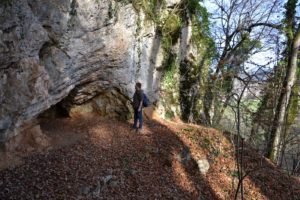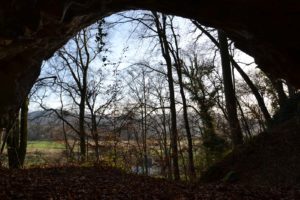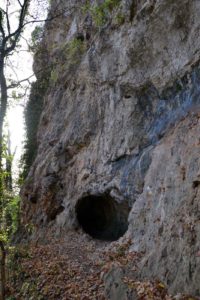10. “Teufelsküche” (vicious kitchen)
Reindeer hunters on the Ölberg
At the end of the last glacial period, 13000 years ago, the humans did not yet have long-term places of residence, but followed the herds of wild game which were their nutritional basis. Three caves situated on the steep eastern slope of the Ölberg between Ehrenstetten and Bollschweil, constitute the oldest still visible traces of human presence in the Breisgau region. They are commonly known as “Teufelsküche” (vicious kitchen). Radiocarbon dating methods show that, 13500 and 11500 years ago, hunters and gatherers camped here several times in winter and spring where they were protected from wind and weather.
From their camp the hunters and gatherers had the best view to their hunting ground, the Möhnlin Valley, and could observe and hunt the herds of reindeers and wild horses. Then mammoths and wooly rhinos were nearly extinct species and therefore hardly possible to hunt. At that time, the Hexental looked completely different than today. On average the climate was about 5 degrees colder than today and in summer even 9 degrees. It rained more rarely and the winter seasons were longer. In the Hexental there was a steppic vegetation with wide areas of grasses and herbs, few pine trees, junipers, dwarf willows and birch trees. The landscape was much more open than today that it permitted a good visibility up from the caves to the passing reindeer herds.
During the excavations, numerous stone tools made and consisting of the Markgräfler flint, were found. These tools served as knives to cut the captured animal. Then the animals were killed by means of spearheads made of reindeer bones which had been produced with cutters of flint.
All findings were discovered during excavations between 1925 and 1926 and further excavations between 1932 and 1934 in the most northern cave. The excavated cave was relatively small with a size of 5 to10 sqm, therefore, one assumes that, at that time, between 10 and 20 humans had camped in front of the cave.


